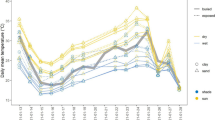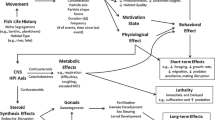Abstract
The decline in anadromous rainbow smelt (Osmerus mordax) populations may be due to anthropogenic causes including spawning habitat degradation. The purpose of this study was to assess the survival of rainbow smelt embryos incubated under sediment layers of different depths (0.00, 0.25, 1.00, and 6.00 g/45.6 cm2) and in contact with periphyton communities of different biomass. Embryo survival was also assessed when cultured on periphyton in combination with sterilized sediment or eutrophying compounds (nitrates and phosphates). Oxygen consumption was monitored from embryos cultured alone, on periphyton layers, and under a sediment layer. Survival was significantly reduced under the highest sediment treatment and attributed to low oxygen availability to the embryos. Embryonic survival was also significantly reduced when incubated on the highest periphyton biomass. Embryos under the sediment layer consumed oxygen at a significantly greater rate than the controls, and the dissolved oxygen concentration below the sediment–water interface decreased to near anoxic. These results suggest that embryonic survival could be impacted in rivers with heavy sedimentation or a high standing biomass of periphyton.




Similar content being viewed by others
References
American Public Health Association (APHA) (1992) Standard methods for the examination of water and wastewater, 18th edn. American Public Health Association, Washington, DC
Ayer MH, Benton C, King W, Kneebone J, Elzey S, Toran M, Grange K, Berlinsky DL (2005) Development of practical culture methods for rainbow smelt larvae. North Am J Aquac 67:202–209
Brooke LT, Colby PJ (1980) Development and survival of embryos of lake herring at different constant oxygen concentrations and temperatures. Progress Fish Cult 42:3–9
Buckley JL (1989) Species profiles: life histories an environmental requirements of coastal fishes and invertebrates (North Atlantic)—rainbow smelt. U.S. Fish and Wildlife Service Biological Report 82 (11.106) U.S. Army Corps of Engineers TR EL-82-4
Carlton RG, Wetzel RG (1987) Distributions and fates of oxygen in periphyton communities. Can J Bot 65:1031–1037
Cech JJ (1990) Respirometry. In: Schreck CB, Moyle PB (eds) Methods for fish biology. American Fisheries Society, Bethesda, pp 335–362
Chase BC, Childs AR (2001) Rainbow smelt (Osmerus mordax) spawning habitat in the Weymouth-Fore River. Massachusetts Division of Marine Fisheries Technical Report TR-5
Crestin DS (1973) Some aspects of the biology of adults and early life stages of the rainbow smelt, Osmerus mordax (Mitchill), from the Weweantic River Estuary, Wareham-Marion, Massachusetts, 1968. M.S. thesis, University of Massachusetts, Amherst, 108 pp
Daykin PN (1965) Application of mass transfer theory to the problem of respiration of fish eggs. J Fish Res Board Can 22:159–171
Fuda KM, Smith BM, Lesser MP, Legare BJ, Breig HR, Stack RB, Berlinsky DL (2007) The effects of environmental factors on rainbow smelt Osmerus mordax embryos and larvae. J Fish Biol 71:539–549
Geffen AJ (1990) Response of rainbow smelt, Osmerus mordax (Mitchill), eggs to low pH. J Fish Biol 37:865–871
Greig SM, Sear DA, Smallman D, Carling PA (2005) Impact of clay particles on the cutaneous exchange of oxygen across the chorion of Atlantic salmon eggs. J Fish Biol 66:1681–1691
Hoagland KD, Roemer SC, Rosowski JR (1982) Colonization and community structure of two periphyton assemblages, with emphasis on the diatom (Bacillariophyceae). Am J Bot 69:188–213
Jorgensen BB, Revsbech NP (1985) Diffusive boundary layers and the oxygen uptake of sediments and detritus. Limnol Oceanogr 30:111–122
Karlström U (1978) Role of the organic layer on stones in detrital metabolism in streams. Vereinigung für Theoretische und Angewandte Limnologie 20:1463–1470
Klein-MacPhee G (2002) Smelts: family Osmeridae. In: Collette BB, Klein-MacPhee G (eds) Bigelow and Schroeder’s fishes of the Gulf of Maine. Smithsonian Institution Press, Washington, DC, pp 162–170
Lahti E, Oksman H, Shemeikka P (1979) On the survival of vendace eggs in different lake types. Aqua Fenn 9:62–67
Lapierre L, Cormier C, Trencia G, Verreault G (1999) Periphyton of four St. Lawrence estuary tributaries used for rainbow smelt spawning. In: First North American workshop on rainbow smelt, Quebec, Quebec, Canada, 21–23 February 1999, pp 33–38
Lapointe MF, Bergeron NE, Bérubé F, Pouliot M, Johnston P (2004) Interactive effects of substrate sand and silt contents, redd-scale hydraulic gradients, and interstitial velocities on egg-to-emergence survival of Atlantic salmon (Salmo salar). Can J Fish Aquat Sci 61:2271–2277
Louhi P, Mäki-Petäys A, Erkinaro J (2008) Spawning habitat of Atlantic salmon and brown trout: general criteria and intragravel factors. River Res Appl 24:330–339
McIntire CD (1966) Some factors affecting respiration of periphyton communities in lotic environments. Ecology 47:918–930
Meyer CB (2003) The importance of measuring biotic and abiotic factors in the lower egg pocket to predict coho salmon eggs survival. J Fish Biol 62:534–548
Morrison JA, Napier IR, Gamble JC (1991) Mass mortality of herring eggs associated with a sedimenting diatom bloom. ICES J Mar Sci 48:237–245
Murawski SA, Cole CF (1978) Population dynamics of anadromous rainbow smelt Osmerus mordax, in a Massachusetts river system. Trans Am Fish Soc 107:535–542
National Oceanic and Atmospheric Administration, NOAA (2004). Species of Concern NOAA National Marine Fisheries Service: rainbow smelt Osmerus mordax. National Marine Fisheries Service, Proactive Conservation Program. Available online at http://www.nmfs.noaa.gov/pr/pdfs/species/rainbowsmelt_detailed.pdf. Accessed 7 Jan 2009
Oseid DM, Smith LL (1971) Survival and hatching of walleye eggs at various dissolved oxygen levels. Progress Fish Cult 33:81–85
Prescott GW (1978) How to know the freshwater algae. William C Brown Company Publishers, Dubuque, 293 pp
Roemer SC, Hoagland KD, Rosowski JR (1984) Development of a freshwater periphyton community as influenced by diatom mucilages. Can J Bot 62:1799–1813
Rombough PJ (1988) Growth, aerobic metabolism, and dissolved oxygen requirements of embryos and alevins of steelhead, Salmo gairdneri. Can J Zool 66:651–660
Shelton JM, Pollock RR (1966) Siltation and egg survival in incubation channels. Trans Am Fish Soc 95:183–187
Smith GM (1950) The freshwater algae of the United States. McGraw-Hill Book Company, Inc., New York, 719 pp
Swanson C (1996) Early development of milkfish: effects of salinity on embryonic and larval metabolism, yolk absorption and growth. J Fish Biol 48:405–421
Thomas S, Gaiser EE, Tobias FA (2006) Effects of shading on calcareous benthic periphyton in a short-hydroperiod oligotrophic wetland (Everglades, FL, USA). Hydrobiologia 569:209–221
Torrans EL (2007) Design and testing of a closed, stirring respirometer for measuring oxygen consumption of channel catfish eggs. North Am J Aquac 69:185–189
Trainor FR (1978) Introductory phycology. Wiley, New York, 542 pp
Ventling-Schwank AR, Livingstone DM (1994) Transport and burial as a cause of whitefish (Coregonus sp.) egg mortality in a eutrophic lake. Can J Fish Aquat Sci 51:1908–1919
Walling DE (1995) Suspended sediments in a changing environment. In: Gurnel AM, Petts GE (eds) Changing river channels. Wiley, Chichester, pp 149–176
Wehr JD, Sheath RG (2003) Freshwater algae of North America, ecology and classification. Academic Press, San Diego, 917 pp
Weitzel RL, Sanocki L, Holecek H (1979) Sample replication of periphyton collected from artificial substrates. In: Weitzel RL (ed) Methods and measurements of periphyton communities: a review, ASTM STP 690. American society for testing and materials, Philadelphia, Pennsylvania, pp 90–115
Wilkonska H, Zuromska H (1982) Effect of environmental factors and egg quality on the mortality of spawn in Coregonus albula (L.) and Coregonus lavaretus (L.). Polskie Archiwum Hydrobiologii 29:123–157
Zar JH (1999) Biostatistical analysis, 4th edn. Prentice Hall, Upper Saddle River, 929 pp
Acknowledgments
This work was supported by the US National Marine Fisheries Service’s Proactive Species Conservation Grant Program. Valuable contributions were made by Katherine Mills and Peter Wellenberger from the Great Bay National Estuarine Research Reserve, Cheri Patterson and Jessica Fischer from the New Hampshire Fish and Game Department, Brad Chase and Scott Elzey from the Massachusetts Division of Marine Fisheries, and John Sowles and Claire Enterline from the Maine Department of Marine Resources. Additionally, we thank Tim Breton, Abigail Walker, and Heidi Colburn for their help during all phases of this study.
Author information
Authors and Affiliations
Corresponding author
Rights and permissions
About this article
Cite this article
Wyatt, L.H., Baker, A.L. & Berlinsky, D.L. Effects of sedimentation and periphyton communities on embryonic Rainbow Smelt, Osmerus mordax . Aquat. Sci. 72, 361–369 (2010). https://doi.org/10.1007/s00027-010-0129-8
Received:
Accepted:
Published:
Issue Date:
DOI: https://doi.org/10.1007/s00027-010-0129-8




